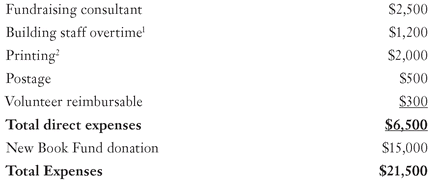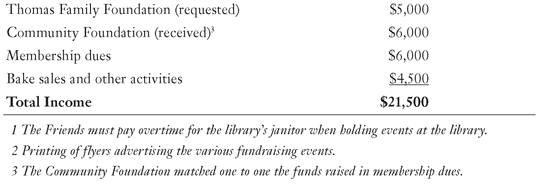Putting It All Together
Here’s a sample budget that includes all I’ve discussed so far. (You can find additional budget examples including a multiyear budget in the appendixes.) This budget is for a program that trains educators to teach literacy skills to adults learning English as a second language.
Literacy Teachers’ Training Program


From this budget presentation, you can see at a glance all the elements of a good budget:
Who: Three staff members and one consultant will run the program. An outside evaluator also will be hired. In addition, the teachers taking part in the program will receive a small stipend.
What: The largest expense is for printing, which the footnote tells us will be for application materials and a teacher’s guide. Participants’ travel will be subsidized.
When: The column header gives the dates of the project.
Where: No direct costs are specified for rent, but footnote 4 tells us that space is covered in the indirect costs.
How: The amount requested from this funder is listed first. Grants that have been received appear next, followed by grant proposals that are outstanding. You’ll note that a small amount ($5,000) does not have a specified source, but the footnote explains where we expect to raise that money.
This budget presentation contains a second column showing exactly how the Bank Foundation’s grant will be used. This foundation specifies that it will not pay for the applicant’s personnel costs or any indirect costs. From the remaining expenses,
I chose to show their money going to the participants and for most of the other direct program expenses. I could have also put their money toward the consultants, but I thought this funder would like to see more of their money going to the participants. Such an allocation of a funder’s grant is not that common, but I’ve encountered more than one who asked that it be done.

WORDS TO THE WISE
When you isolate the exact expenses a grant will pay for, you make reporting more difficult because you will report on smaller sums, which are more likely to vary. Only do this if required by the funder.
This two-column presentation is also effective when you’re asking a funder for a grant for a particular activity that’s part of a larger program. Showing the larger program gives a fuller picture of what your charity is doing to address a problem, but separating out a particular activity allows funders to get a better picture of what they will be paying for. For example, if this teacher training program included a summer camp for kids learning English and you had a funder interested in that part of the program, you might pull out the camp expenses in a second column so the funder could see what it would be supporting and what other funders were helping to support the camp.
If, instead of footnotes, you wanted to (or were asked to) include a budget narrative, it might read like the following:
Agency staff will conduct the teacher training, assisted by a consultant. The program evaluator will follow the program and write a report on its effectiveness, which we will share with funders. Participants will receive a small stipend, travel subsidy, and lunches each day of training. Printing a teacher’s guide is the single largest nonpersonnel expense.
Five additional grant proposals have been submitted, all but one to new funders. Several board members are also expected to contribute through their family foundations toward this total. We are confident we will raise the remaining funds. Should the funds raised fall somewhat short of the goal, we can reduce or postpone the role of the evaluator to the following year.
The income section shows that nearly two thirds of the total cost has already been received. This funder, the Community Foundation, and a number of unnamed other outstanding requests will be expected to make up the balance to cover administrative costs. Had there been solid prospects for the additional costs at the time you submitted this application, you would have given the names of those prospects. If too large a proportion of the income appears in “other funders,” the funder might doubt your ability to fund the program completely.

PHILANTHROPY FACT
Although I’ve repeatedly pointed out that you should not include fundraising costs in program budgets, some funders will make grants specifically to pay for additional fundraising consultants or staff, usually under the heading of “capacity building.”
In some cases, your project and organizational budget may be the same. For example, if you’re raising funds for the Friends of the Hometown Library, you might devote virtually your entire budget to raising money for the library. Fundraising expenses can appear in this budget because that’s pretty much all the Friends group does. You won’t, however, be asking for a grant to cover fundraising costs but rather to support the library in some specific way. If the Friends organization has its own nonprofit status, its budget might look something like this one.
Expenses

Income

If the Friends organization were not tax-exempt, you would need to apply to the foundation using the library’s status, and therefore would use the library’s total budget with your proposal. In this case, you’d separate out (and subtotal) the Friends’ expenses. You would also highlight the Friends’ donations to the library from its various fundraising activities in the income section.
..................Content has been hidden....................
You can't read the all page of ebook, please click here login for view all page.
